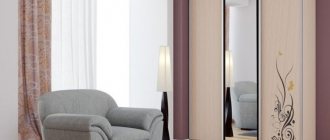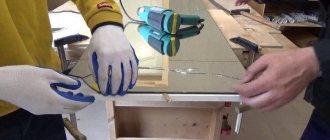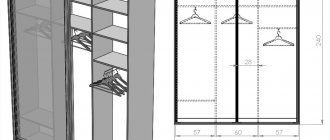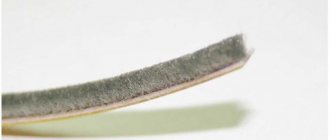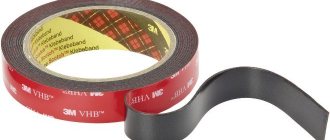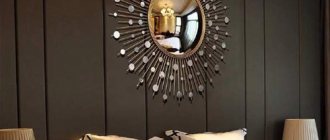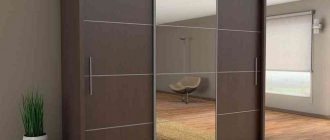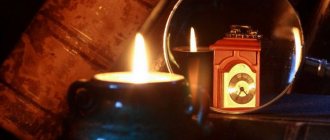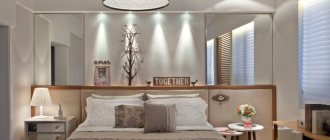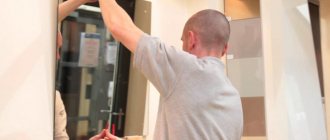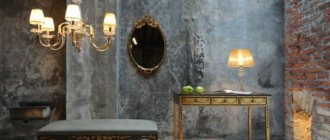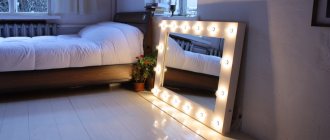There comes a time when the usual surroundings become boring. I want to change something, update the old interior, add some detail or make a good repair. The best way to update a room, make it brighter, and perhaps even increase the space, is to attach a mirror to the closet. You have purchased new furniture, you need to glue a mirror to the cabinet door, and you don’t know how to do it correctly, let’s look at individual mounting methods.
The best way to update a room, make it brighter, and perhaps even increase the space, is to attach a mirror to the closet.
We apply “Liquid nails” or silicone to the mirror surface in parallel lines at equal intervals.
Types of fastening methods
How to glue a mirror to a cabinet? How to do this job correctly? There are several ways to glue a mirror.
| Method name | Features of the method |
| Mounting double-sided tape. | This material must be chosen correctly. The adhesive tape should be high-grade - 3M, foamed, its thickness should be 0.8-2 mm (to even out unevenness). It is possible to work with it at temperatures from +10 to +25°C. Indicators higher or lower will not provide adequate grip. The tape consumption is 60 cm² per 1 kg of mass. |
| Using “liquid nails”, special glue or colorless construction silicone. | There are some nuances: it is better not to glue the mirror to “liquid nails” or other products that have a characteristic odor. The substance contained in them can lead to damage to the amalgam. It is better to purchase special adhesives for mirrors - “Titan” (the most reliable product), “Abro”, “Soudal”, “Bostik 2750”. A very high-quality and handy method is gluing a mirror to silicone. This is the best option. |
| Mechanical method. | Using U-shaped metal tabs, plastic stops or special screws. |
You have purchased new furniture, you need to glue a mirror to the cabinet door, and you don’t know how to do it correctly, let’s look at individual mounting methods.
The best option is to glue the mirror onto colorless silicone for construction.
Attention! Which gluing option to choose is up to you to decide. The main thing is not to rush, do all the work scrupulously, approach the matter responsibly, then the mirror will be attached firmly enough and will last a long time.
How to glue a mirror to a cabinet?
Remove the protective stickers from the tape.
How can you attach a mirror to a cabinet door?
The mirror on the cabinet door performs several functions:
- The direct function of a mirror is to reflect objects. With its help, you can evaluate the selected outfit without moving far from the shelves, and, if necessary, adjust it.
- If the room is small, then finding a place for a full-length mirror is problematic. But you can hang it on the closet.
- Mirrors solve another problem of small rooms - they visually expand the space and make the room brighter.
- If a piece of furniture is in the hallway, then the reflection can improve the lighting in the hallway. As a rule, the corridors are always quite dark due to their elongated shape and the lack of windows. It's difficult to get light into all corners. A mirror, reflecting light from a chandelier, will help make the room brighter.
You can attach a mirror vertically to a door or cabinet wall in the following ways:
- stick with double-sided tape;
- glue with glue or liquid nails;
- attach using metal tabs or screws.
Necessary materials
Before you begin, you need to prepare the following materials: mirror, liquid nails, glue or silicone for gluing the mirror, double-sided tape, masking tape, degreaser.
There are several ways to glue a mirror.
Now you need to wait for the glue to dry.
To the tile
Similar to the previous methods, before starting the process, you should clean the surface of the tile from debris. For degreasing, use alcohol, acetone or white spirit. This should be done in several stages, each time waiting for it to dry.
Some problem is the difference in height between adjacent tiles, which can lead to the mirror being skewed and not fitting tightly. To avoid this, you should level the surface by applying a layer of plaster to it. Before gluing the mirror to the wall in the bathroom, it is recommended to apply a sealant.
If the mirror has a large area, it is necessary to install a supporting base.
Required Tools
The following tools will be useful: sandpaper, mounting gun, pencil, ruler or tape measure. If you are going to screw the mirror onto the mount, then you will need a drill, a screwdriver, screwdrivers, regular drills, a diamond drill (to make a hole in the mirror), and a special mount for mirrors.
Which gluing option to choose is up to you to decide.
If you decide not to use “liquid nails”, but to attach them to the legs, then you need to make sure that they are manufactured accurately in height and, if necessary, install spacers.
Can this be done according to Feng Shui?
Let's consider whether it is possible to place a mirror on the front door of an apartment according to Feng Shui. According to the teaching, it is through the front door that positive energy comes into the home. It does not particularly encourage placing a mirror on it, but it does not prohibit it either. So, the mirror on the door should be positioned so that nothing interferes with the access of positive energy.
The canvas should not reflect the bathroom, kitchen or toilet . It is also desirable that a person sees his full reflection in it.
When placing a mirror on the front door, according to Feng Shui, there is no need to hang another mirror opposite it so that they are reflected in each other. In the teaching it is believed that this can cause good luck to leave home.
Fastening process: step-by-step instructions
So, you stocked up on all the materials and tools and purchased a mirror of the required size. It is preferable if its back side is protected with a special film, which, if the mirror breaks, will prevent fragments from falling off. Now let's get to work.
You can use fine sandpaper for better adhesion of the glue.
Before fixing the mirror, you need to place a soft layer, and then press the mirror with paws.
First, remove the cabinet door. To make it easier to work with, you need to place it in a horizontal position. Using a pencil, draw marking lines on the surface. Use a degreaser to clean the door, then the mirror. You can use fine sandpaper for better adhesion of the glue. Use a brush to remove all the dust.
Use a degreaser to clean the door, then the mirror.
If the mirror has ready-made holes, you can use special screws instead of the tabs.
We apply “Liquid nails” or silicone to the mirror surface in parallel lines at equal intervals. Between them, for auxiliary fastening, we glue strips of double-sided tape. The best option is to glue the mirror onto colorless silicone for construction. There is no need to use only adhesive tape, since a mirror glued in this way may fall after some time, especially when the room is very warm or you are doing work in the summer.
First, remove the cabinet door.
To prevent the glass from cracking, the mirror surface must be wetted all the time or a side made of plasticine must be made and water poured into it.
Remove the protective stickers from the tape. We fix the long edge of the mirror on the marking line. Slowly, we lower the mirror surface, trying to prevent displacement. It is better if an assistant works with you. He will make sure that the mirror lies flat, without going beyond the applied markings. That's it, the mirror is glued. Now you need to wait for the glue to dry. Optimally, a day is allotted for this. The door can be secured in place.
So, you stocked up on all the materials and tools and purchased a mirror of the required size.
The mirror should lie on cardboard or fabric.
If you decide not to use “liquid nails”, but to attach them to the legs, then you need to make sure that they are manufactured accurately in height and, if necessary, install spacers. They should be close to the mirror, but without tension. You also remove the door from the cabinet, lay it horizontally, mark where the holes for fastening the tabs should be, screw them, and bend them. Before fixing the mirror, you need to place a soft layer, and then press the mirror with paws.
The following tools will be useful: sandpaper, mounting gun, pencil, ruler or tape measure.
Gluing a mirror to a cabinet door is not that difficult; all the work must be done very carefully.
If the mirror has ready-made holes, you can use special screws instead of the tabs. In case there are no holes, they are drilled with a diamond drill in the corners. To prevent the glass from cracking, the mirror surface must be wetted all the time or a side made of plasticine must be made and water poured into it. The mirror should lie on cardboard or fabric. Plastic washers must be inserted under the screw heads.
Before you begin, you need to prepare your materials.
As a result, the interior of the room will be greatly transformed.
Gluing a mirror to a cabinet door is not that difficult; all the work must be done very carefully. As a result, the interior of the room will be greatly transformed. It is not necessary for the mirror to be rectangular or square. It can be of any original shape. It is important that it fits the overall situation.
The main thing is not to rush, do all the work scrupulously, approach the matter responsibly, then the mirror will be attached firmly enough and will last a long time.
It is not necessary for the mirror to be rectangular or square.
It is important that it fits the overall situation.
So let's get down to business:
First you need to remove the old tape.
I heated it with a household hairdryer and cut it off with a knife: some part remained on the mirror, and I tried to wipe off the residue with a solvent, but I quickly got tired of this process. These remnants do not affect anything, let them remain.
Now you need to degrease both surfaces
. This can be done with solvent or acetone.
We stick the tape in small pieces, but more often
.
We remove the protective layer, take aim and firmly press the mirror against the door for a minute.
I don’t know what kind of tape they use at the factory that made this cabinet, but it’s a bit loose, 3M looks much denser.
That’s it, the mirror is in place and this time, I think, it won’t fall off.
I wonder if the top mirror will also have to be re-glued soon.
Subscribe to the channel so as not to miss new publications.
My VKontakte group:
Carpentry workshop “Master’s Work”
Instagram:
@crimean_woodworking
Method No. 4 Sliding wardrobe with stained glass windows - economical option
Only very wealthy people have the opportunity to decorate wardrobe doors with stained glass windows. We offer a decoration method that will allow you to experience all the delights of stained glass decoration without significant costs.
The technology is extremely simple. A translucent stained glass film with an adhesive surface is applied to the mirrored door of a sliding wardrobe. The film transmits light, which returns to us through reflection. The result is a glowing effect similar to reflection from colored glass. Applying stained glass to a wardrobe mirror is as easy as a regular vinyl sticker. Check out the decorative effect.
Stained glass films from the Crystal Frost series are perfect for decorating wardrobe mirrors, glass doors and partitions, and shower stalls. An exquisite translucent pattern will make the glass surface attractive and open up space zoning possibilities. Several surface patterns are available to order
Installation of hinges for glass furniture
The performance of the hinge is influenced by several parameters: the accuracy of insertion and installation, the quality of the hinge itself and the nature of its operation.
The easiest way to install a glass door is using hinged awnings. In this case, there is no need to drill the door. The sequence of actions in this case is as follows:
- Markings are applied at the location of the hinges (on the base and on the door itself).
- Then the furniture hinges for glass are opened and glass is inserted into the resulting groove.
Inserting glass into a hinge
- Next, the clamping bolts are tightened tightly.
Tightening the clamp bolts
- After this, the door is attached to the base, in the places previously marked for the hinges.
If the weight of the door being hung exceeds 20-25 kg, the installation method with drilling is used. For this:
- At the bottom and top of the door (at a distance of 1/3 of the door height) the location for installing the canopy is marked.
- Then, at the marking site, holes are drilled for mounting bolts/screws. To do this, you will need a drill and a glass drill of the required diameter. You can see the drilling technology in the video below.
- After the holes are ready, the hinge is installed on the door and secured with bolts.
- The canopy strike plate is attached directly to the cabinet body according to the markings.
After hanging the door, you should check the smoothness of its movement
After this, all that remains is to hang the door, check the smoothness of its movement, the presence of distortions in the open and closed positions and gaps between the door and the frame, and make sure that there are no extraneous creaks or backlashes.
When installing a glass door at home, you should perform the work extremely carefully, since the glass can crack even from excessive pressure from the drill during drilling. Inexperienced craftsmen should opt for hinge-type hinges for glass furniture doors, the installation of which does not require special skills and equipment.
How and with what to fasten glass?
Today, manufacturers offer several types of special fittings that help protect glass surfaces from damage.
Types of fittings
The selection of fittings and fastening methods for glass and mirror panels is a very important and responsible step. Today, several types of fittings are offered:
- holders;
- brackets
- shelf holders
- pendants;
- hooks;
- plates.
Mirror structures and products require special fittings, which, when attached to a wall or furniture, will not disrupt the reflective qualities of the mirror.
As a rule, hidden fittings are used for this. It is fixed on the back of the mirror or decorative plugs are used. This does not interfere with the visual appearance of mirror products. Shelves can be installed inside furniture or a niche, so special small-sized fittings are used for them and are practically invisible from the outside. But shelves can be hung openly on the wall. For such glass shelves, special shelf holders are used. When creating and selecting them, the physical characteristics of glass and weight are taken into account. Fastening fittings are selected according to the thickness and standard size of the shelf used, so they are often purchased individually. Such shelf holders are equipped with elastic inserts made of rubber or silicone, which help keep the glass from moving in the horizontal direction and dampen vibrations.
Glass furniture is a separate category of products. It uses unique fittings. Glass tables and cabinets are made with extreme care. In sliding wardrobes, the hinge can fix the glass in two ways, which differ in the method of attaching the glass or mirror to the hinges. The sheet material can be inserted into the gap between the hinge grooves and secured with screws, or it can be fixed on the front side with a nut, which is closed with a decorative element.
Plexiglas products
Plexiglas is a transparent, solid synthetic material made from polymers such as polyacrylate and polystyrene. Previously, plexiglass products were not as high quality as modern polymers.
If we compare organic glass with mineral glass, we can note certain advantages and disadvantages of the polymer.
Plexiglas is a lightweight material and is almost impossible to break. Polymer glass is easy to process. At the same time, organic glass is easily scratched and loses its transparency. The polymer burns, releasing toxic substances into the atmosphere.
Plexiglas is not suitable for making mirrors. But they make beautiful shelves and display cases from it.
What kind of glue can I use?
The second method of attaching a mirror to the door involves using glue. Not any adhesive composition is suitable for such work. You should take specifically that glue, the annotation of which indicates that it can be used to glue glass or a mirror to vertically placed surfaces.
Glue brands that are suitable for gluing mirrors to chipboard:
- "Tytan" A product from a Polish manufacturer based on organic resins and rubber. Characterized by the highest adhesion and water resistance. The main advantage is that it preserves the amalgam. For proper application, both surfaces are degreased, then one of them is coated with glue (the distance between the strips should be 5 cm, the distance from the edges should be 2 cm). The product dries in a couple of minutes, but if the mirror is hanging crookedly, it can be moved within 1–2 minutes without harming the adhesion strength.
- "Abro." Two-component adhesive glues not only glass to wood and chipboard, but also glass fragments to each other. The package contains two ampoules, one contains an epoxy adhesive base, and the other contains an activator. Before application, these substances must be mixed together in a separate container and then applied to the surface. Ultra-strong fixation allows you to use the product even for gluing rear-view mirrors in cars. Dries in 1–2 minutes.
- "Loctite" Like the previous brand, it contains two components: an adhesive base and an activator. The packaging is enough for either one full-length mirror or two small ones. There is also a one-component cyanoacrylate adhesive for surfaces that are difficult to bond, and an aerosol composition.
- "Permatex". One-component auto glue, which is also used for gluing glass to furniture. Made on the basis of cyanoacrylate, it gives a very strong grip. Waterproof, which means it is suitable for attaching mirrors in the bathroom.
- "DoneDeal". Almost all craftsmen advise using silicone compounds for working with mirrors, and this adhesive-sealant is just one of them. One of the areas of implementation is the fastening of decorative mirror panels. Suitable for gluing small mirrors; it will not hold powerful ones.
Through fasteners (with drilling) for confirmations
Confirmats are the most common through fasteners for shelves. To install, you will need to drill a hole in the end of the shelf with a diameter of 5 mm and on the front side of the side of the cabinet with a drill with a diameter of 8 mm. It is better to use a special confirmation drill. Since a countersink is still required for the head, the screw itself is flush with the surface of the sidewall. Next, the cap is hidden with a special self-adhesive plug, matched to the color of the chipboard.
A nuance: depending on the thickness of the sidewalls, the length of the confirmat is selected. For standard chipboard and MDF thicknesses of 16-18 mm, a 5x50 euroscrew is used; for thicker board materials, a longer one is used, up to 70 mm.
- Among the advantages of attaching shelves to confirmations, it is worth highlighting the ease of assembly and the low cost of the fasteners themselves.
- The downside is the need to drill through. Not everyone likes the “holey” sides of the cabinet from an aesthetic point of view. Although the self-adhesive plugs are color-matched, they are still visible. Also furniture assembled through repeated assembly and disassembly.
